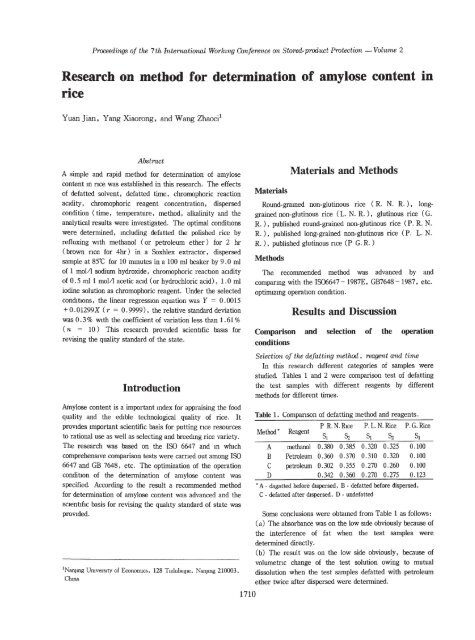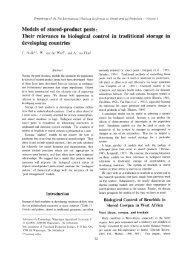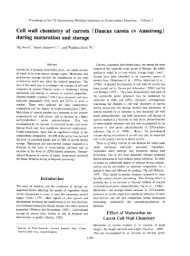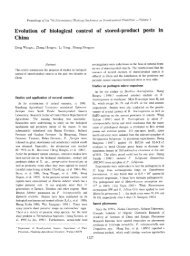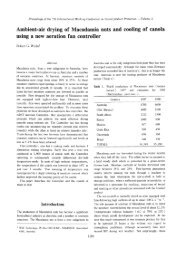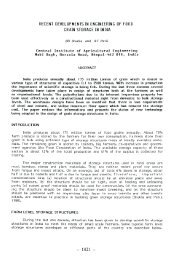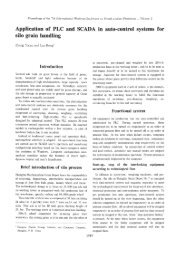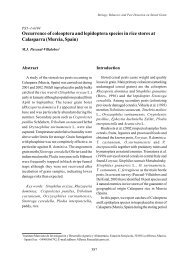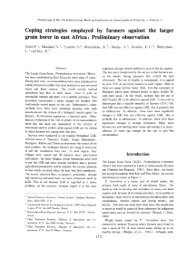Research on method for determination of amylose content in rice
Research on method for determination of amylose content in rice
Research on method for determination of amylose content in rice
You also want an ePaper? Increase the reach of your titles
YUMPU automatically turns print PDFs into web optimized ePapers that Google loves.
Proceed<strong>in</strong>gs <strong>of</strong> the 7 th Internati<strong>on</strong>al Worktng C<strong>on</strong>ference <strong>on</strong> Stored-product Protecti<strong>on</strong> - Volume 2<br />
<str<strong>on</strong>g>Research</str<strong>on</strong>g> <strong>on</strong> <strong>method</strong> <strong>for</strong> determ<strong>in</strong>ati<strong>on</strong> <strong>of</strong> <strong>amylose</strong> c<strong>on</strong>tent <strong>in</strong><br />
<strong>rice</strong><br />
Yuan jian, Yang Xiaor<strong>on</strong>g, and Wang Zhaoci 1<br />
Abstract<br />
A simple and rapid <strong>method</strong> <strong>for</strong> determ<strong>in</strong>ati<strong>on</strong> <strong>of</strong> <strong>amylose</strong><br />
c<strong>on</strong>tent m nee was established <strong>in</strong> this research. The effects<br />
<strong>of</strong> defatted solvent, defatted time, chromophoric reacti<strong>on</strong><br />
acidity, chromophoric reagent c<strong>on</strong>centrati<strong>on</strong>, dispersed<br />
c<strong>on</strong>diti<strong>on</strong> (time, temperature, <strong>method</strong>, alkal<strong>in</strong>ity and the<br />
analytical results were <strong>in</strong>vestigated. The optimal c<strong>on</strong>diti<strong>on</strong>s<br />
were determ<strong>in</strong>ed, <strong>in</strong>clud<strong>in</strong>g defatted the polished <strong>rice</strong> by<br />
reflux<strong>in</strong>g With methanol (or petroleum ether) <strong>for</strong> 2 hr<br />
(brown nee <strong>for</strong> 4hr) <strong>in</strong> a Soxhlex extractor, dispersed<br />
sample at 85'C <strong>for</strong> 10 m<strong>in</strong>utes <strong>in</strong> a 100 ml beaker by 9.0 ml<br />
<strong>of</strong> 1 mol/l sodium hydroxide, chromophoric reacti<strong>on</strong> acidity<br />
<strong>of</strong> 0.5 ml 1 mol/l acetic acid (or hydrochloric acid), 1.0 ml<br />
iod<strong>in</strong>e soluti<strong>on</strong> as chromophoric reagent. Under the selected<br />
c<strong>on</strong>di ti<strong>on</strong>s, the l<strong>in</strong>ear regressi<strong>on</strong> equati<strong>on</strong> was Y = 0.0015<br />
+ 0.01299X (r = 0.9999), the relative standard deviati<strong>on</strong><br />
was 0.3% WIth the coefficient <strong>of</strong> variati<strong>on</strong> less than 1.61 %<br />
(n = 10) This research provided scientific baSIS <strong>for</strong><br />
revis<strong>in</strong>g the quality standard <strong>of</strong> the state.<br />
Introducti<strong>on</strong><br />
Amylose c<strong>on</strong>tent is a important <strong>in</strong>dex <strong>for</strong> apprais<strong>in</strong>g the food<br />
quality and the edible technological quality <strong>of</strong> <strong>rice</strong>. It<br />
provides Important scientific basis <strong>for</strong> putt<strong>in</strong>g nee resources<br />
to rati<strong>on</strong>al use as well as select<strong>in</strong>g and breed<strong>in</strong>g <strong>rice</strong> variety.<br />
The research was based <strong>on</strong> the ISO 6647 and m which<br />
comprehensive comparis<strong>on</strong> tests were carried out am<strong>on</strong>g ISO<br />
6647 and GB 7648, etc. The optimizati<strong>on</strong> <strong>of</strong> the operati<strong>on</strong><br />
c<strong>on</strong>diti<strong>on</strong> <strong>of</strong> the determ<strong>in</strong>ati<strong>on</strong> <strong>of</strong> <strong>amylose</strong> c<strong>on</strong>tent was<br />
specified. Accord<strong>in</strong>g to the result a recommended <strong>method</strong><br />
<strong>for</strong> determ<strong>in</strong>ati<strong>on</strong> <strong>of</strong> <strong>amylose</strong> c<strong>on</strong>tent was advanced and the<br />
scientific<br />
provided.<br />
basis <strong>for</strong> revis<strong>in</strong>g the quality standard <strong>of</strong> state was<br />
INanjlng Uruversrty <strong>of</strong> Ec<strong>on</strong>orrucs, 128 Trelubeure, Nanjmg 210003,<br />
Chma<br />
Materials<br />
Materials and Methods<br />
Round-gra<strong>in</strong>ed n<strong>on</strong>-glut<strong>in</strong>ous <strong>rice</strong> (R. N. R.), l<strong>on</strong>ggra<strong>in</strong>ed<br />
n<strong>on</strong>-glut<strong>in</strong>ous <strong>rice</strong> (1. N. R. ), glut<strong>in</strong>ous <strong>rice</strong> (G.<br />
R. ), published round-gra<strong>in</strong>ed n<strong>on</strong>-glut<strong>in</strong>ous <strong>rice</strong> (P. R. N.<br />
R. ), published l<strong>on</strong>g-gra<strong>in</strong>ed n<strong>on</strong>-glut<strong>in</strong>ous <strong>rice</strong> (P. 1. N.<br />
R. ), published glut<strong>in</strong>ous nee (P G. R. )<br />
Methods<br />
The recommended <strong>method</strong> was advanced by and<br />
compar<strong>in</strong>g with the 1806647 -1987E, GB7648 -1987, etc.<br />
optirmzmg operati<strong>on</strong> c<strong>on</strong>diti<strong>on</strong>.<br />
Results and Discussi<strong>on</strong><br />
Comparis<strong>on</strong> and selecti<strong>on</strong> <strong>of</strong> the operati<strong>on</strong><br />
c<strong>on</strong>diti<strong>on</strong>s<br />
Selecti<strong>on</strong> <strong>of</strong> the defatt<strong>in</strong>g <strong>method</strong>, reagent and time<br />
In this research different categories <strong>of</strong> samples were<br />
studied. Tables 1 and 2 were comparis<strong>on</strong> test <strong>of</strong> defatt<strong>in</strong>g<br />
the test samples with different reagents by different<br />
<strong>method</strong>s <strong>for</strong> different times.<br />
Table 1. Compans<strong>on</strong> <strong>of</strong> defatt<strong>in</strong>g <strong>method</strong> and reagents.<br />
Method* Reagent<br />
P R. N. RIce<br />
51 Sz<br />
P. 1.N. Rice<br />
51 Sz<br />
P. G. Rice<br />
51<br />
A methanol 0.380 0.385 0.320 0.325 0.100<br />
B Petroleum 0.360 0.370 0.310 0.320 0.100<br />
C petroleum 0 .302 0 .355 0 .270 0 .260 O.100<br />
D 0.342 0.360 0.270 0.275 0.123<br />
* A - dagatted be<strong>for</strong>e dispersed, B - defatted be<strong>for</strong>e dispersed,<br />
C - defatted after dispersed, D - undefatted<br />
Some c<strong>on</strong>clusi<strong>on</strong>s were obta<strong>in</strong>ed from Table 1 as follows:<br />
(a) The absorbance was <strong>on</strong> the low SIde obviously because <strong>of</strong><br />
the <strong>in</strong>terference <strong>of</strong> fat when the test samples were<br />
determ<strong>in</strong>ed directly.<br />
(b) The result was <strong>on</strong> the low side obviously, because <strong>of</strong><br />
volumetric change <strong>of</strong> the test soluti<strong>on</strong> ow<strong>in</strong>g to mutual<br />
dissoluti<strong>on</strong> when the test samples defatted with petroleum<br />
ether<br />
1710<br />
twice after dispersed were determ<strong>in</strong>ed.
Proceedmqe <strong>of</strong> the 7 th Internati<strong>on</strong>al Work<strong>in</strong>g C<strong>on</strong>ference <strong>on</strong> Stored-product Protecti<strong>on</strong> - Volume 2<br />
(c) The result by defatt<strong>in</strong>g WIth petroleum ether was a httle<br />
less than with methanol. So methanol was taken <strong>for</strong> the<br />
defatt<strong>in</strong>g reagent In this research<br />
Table 2 shows that the <strong>in</strong>terference <strong>of</strong> fat was elim<strong>in</strong>ated<br />
Table 2. Comparis<strong>on</strong> tests <strong>of</strong> different times and reagents.<br />
Sample<br />
P.R.N.Rice<br />
P.L.N Rice<br />
Brown Rice<br />
Methanol<br />
0.323<br />
0.318<br />
0.230<br />
2 hours<br />
Petroleum ether<br />
0.310<br />
0.310<br />
0.250<br />
Selectum <strong>of</strong> dispereum. <strong>method</strong> and c<strong>on</strong>diti<strong>on</strong><br />
Two <strong>method</strong>s <strong>of</strong> dispersi<strong>on</strong> were compared (see Table 3) .<br />
One was that the test samples were dispersed directly <strong>in</strong> a<br />
100 ml volumetric flask, another was that the test samples<br />
were dispersed <strong>in</strong> a beaker, then the suspensi<strong>on</strong> was<br />
transferred quantitatively to a 100 ml volumetric flask and<br />
diluted to volume mark with water and mixed fully.<br />
The determ<strong>in</strong>ed deviati<strong>on</strong> <strong>of</strong> dispers<strong>in</strong>g samples <strong>in</strong> the<br />
volumetric<br />
beaker.<br />
flask directly were bigger than dispers<strong>in</strong>g <strong>in</strong><br />
The reas<strong>on</strong> is that amount <strong>of</strong> the test sample is few and<br />
the test sample is apt to lose or adhere to wall when it was<br />
transferred <strong>in</strong>to volumetric flask. So this <strong>method</strong> is adopted.<br />
Table 3. Comparis<strong>on</strong> <strong>of</strong> dispersi<strong>on</strong> <strong>method</strong>s.<br />
No. Method Absorbance Average<br />
Max.<br />
De<br />
vian<strong>on</strong><br />
1 A 0.334 0.344 0.332 0.330 0.335 0.014<br />
B 0.340 0.336 0.335 0.335 0.336 0.005<br />
2 A 0.300 0.320 0.316 0.318 0.314 0.020<br />
B 0.310 0.305 0.312 0.315 0.311 0.010<br />
3 A 0.352 0.350 0.370 0.350 0.357 0.020<br />
B 0.335 0.360 0.360 0.360 0.359 0.005<br />
In this research the test samples were dispersed at 70,<br />
85, or 100'C <strong>for</strong> 10 m<strong>in</strong>. , as well as at ambient temperature<br />
<strong>for</strong> 24 hrs. The result is shown In Table 4.<br />
In accordance WIth Table 4, the results were Identical <strong>on</strong><br />
the whole <strong>of</strong> samples dispersed at 85 and 100°C <strong>for</strong> 10 to 15<br />
m<strong>in</strong>. and at ambient temperature <strong>for</strong> 24 hrs.<br />
Table 4. Comparis<strong>on</strong> <strong>of</strong> dispersi<strong>on</strong> temperature and<br />
dispersi<strong>on</strong> times.<br />
No.<br />
Ambientt 24 hr)<br />
Absorbance<br />
70'C 85'C 100'C<br />
4 0.230 0.230 0.230 0.240<br />
5 0.290 0.290 0.280 0.290<br />
6 0.270 0.275 0.270 0.270<br />
when the <strong>rice</strong> was defatted by reflux<strong>in</strong>g with methanol <strong>for</strong> 2<br />
hr <strong>in</strong> a Soxhlet extractor or brown <strong>rice</strong> with methanol <strong>for</strong> 4<br />
hr , it was unnecessary <strong>for</strong> 16 hr.<br />
Methanol<br />
4 hours<br />
Petroleum ether<br />
0.336<br />
0.318<br />
0.280<br />
1711<br />
0.320<br />
0.312<br />
0.270<br />
Methanol<br />
24 hours<br />
Petroleum ether<br />
0.355<br />
0.320<br />
0.270<br />
0.325<br />
0.310<br />
0.260<br />
Comparis<strong>on</strong> was carried out that different volumes <strong>of</strong> the 1<br />
mollL sodium hydroxide soluti<strong>on</strong> used <strong>for</strong> dispers<strong>in</strong>g the test<br />
samples, the result is shown <strong>in</strong> Table 5.<br />
Table 5. Influence <strong>of</strong> volumes <strong>of</strong> alkali (Imol/L NaOH) <strong>for</strong><br />
the test sample dispers<strong>in</strong>g.<br />
Sample<br />
7<br />
8<br />
Absorbance<br />
5.0 ml 9.0 ml 15.0 ml<br />
0.354<br />
0.285<br />
0.358<br />
0.290<br />
0.360<br />
0.290<br />
Table 5 showed that the results were Identical <strong>on</strong> the<br />
whole <strong>of</strong> accordant when 9.0 ml or 15.0 ml <strong>of</strong> 1.0 mollL<br />
NaOH was added as dispers<strong>in</strong>g reagent.<br />
500 100 800<br />
600<br />
Fig. 1. Absorpti<strong>on</strong> spectrum under different acidity,<br />
1 CH3CROOB<br />
2 11:1<br />
Selecti<strong>on</strong> <strong>of</strong> the acid and<br />
reaciuni<br />
the acidity m. chrorrwphoric<br />
1 .0 ml <strong>of</strong> 1 mol/L acetic acid or 1.0 ml <strong>of</strong> 1 mol/L<br />
hydrochloric acid is added to potato <strong>amylose</strong> standard<br />
soluti<strong>on</strong>, then carry out chromophoric reacti<strong>on</strong>. The<br />
absorpti<strong>on</strong> spectrum was determ<strong>in</strong>ed. FIgure 1 showed that<br />
their absorpti<strong>on</strong> spectrum was accordant.<br />
Comparis<strong>on</strong> were carried out that different volumes <strong>of</strong>
Proceedittgs <strong>of</strong> the 7th Internatwnal Workittg C<strong>on</strong>ference <strong>on</strong> Stored-product Protectum - Volume 2<br />
acetic acid was added respectively to test samples soluti<strong>on</strong>,<br />
and hydrochloric acid to <strong>amylose</strong> and amylopectm standard<br />
soluti<strong>on</strong>s (Figure 2).<br />
FIgure 2 show that the absorbance <strong>of</strong> test samples soluti<strong>on</strong><br />
and standard soluti<strong>on</strong> are basically steady when 0.3 ml to<br />
1.0 ml 1mollL aceticacid or 1 mollL HCI IS added m<br />
chromoph<strong>on</strong>c reacti<strong>on</strong>. There<strong>for</strong>e, 0.5 ml <strong>of</strong> 1 mollL acetic<br />
acid or hydrochl<strong>on</strong>c acid was used.<br />
0.8<br />
0.6<br />
0.4<br />
0.2<br />
Hel<br />
ar• 0.2 0.4 0.6 0.8 1.0 ml<br />
Fig. 2. Effects <strong>of</strong> the volumes <strong>of</strong> acids.<br />
Selecti<strong>on</strong> <strong>of</strong> the volurne <strong>of</strong> iod<strong>in</strong>e soluti<strong>on</strong> as the<br />
chromophoric reagent<br />
Different volumes <strong>of</strong> iodme soluti<strong>on</strong> were added<br />
respectively to mixture WIth 1.0 ml <strong>of</strong> 1 mg/ml <strong>amylose</strong><br />
standard soluti<strong>on</strong> and 1.5 ml <strong>of</strong> 1 mg/ml amylopectm<br />
standard soluti<strong>on</strong>. Then these soluti<strong>on</strong>s were diluted to 50<br />
ml. The results <strong>of</strong> compans<strong>on</strong> are shown m FIg 3 FIgure 3<br />
shows that the aosorbance was basically steady when the<br />
volumes <strong>of</strong> iod<strong>in</strong>e soluti<strong>on</strong> changed from 0.8 to 1.5 ml.<br />
There<strong>for</strong>e, 1.0 ml <strong>of</strong> Iod<strong>in</strong>e soluti<strong>on</strong> as chromoph<strong>on</strong>c<br />
reagent ISadopted m tlus research.<br />
0.4 0.8 1.2<br />
Fig. 3. Effects <strong>of</strong> the volumes <strong>of</strong> iod<strong>in</strong>e soluti<strong>on</strong>.<br />
Preparati<strong>on</strong> <strong>of</strong> the calibrati<strong>on</strong>. curve<br />
Mix <strong>amylose</strong> and amylopect<strong>in</strong> standard suspensi<strong>on</strong>s (see<br />
Blank test <strong>in</strong> Procedure) and the O. 09molIL NaOH 2.50 ml<br />
<strong>of</strong> each calibrati<strong>on</strong> soluti<strong>on</strong> was pipetted mto 50ml test<br />
ml<br />
1712<br />
tubes, then color developed and colorimetric analysis,<br />
Prepare the calibrati<strong>on</strong> curve by plott<strong>in</strong>g absorbance vs. the<br />
<strong>amylose</strong> c<strong>on</strong>tent Result was expressed as a percentage by<br />
mass, <strong>in</strong> the nulled <strong>rice</strong> <strong>on</strong> the dry baSIS. The l<strong>in</strong>ear<br />
regressi<strong>on</strong> equati<strong>on</strong> was Y = 0.0015 + 0.01299X (r =<br />
0.9999). Result was shown m FIg. 2.<br />
In additi<strong>on</strong>, the <strong>method</strong> that defatted milled nee flours <strong>of</strong><br />
predetermmed <strong>amylose</strong> c<strong>on</strong>tent may be used <strong>for</strong> the<br />
calibrati<strong>on</strong> m place <strong>of</strong> <strong>amylose</strong> and amylopectm suspensi<strong>on</strong>s<br />
was adopted m tlus research. That can omit tedIOUSand<br />
time-c<strong>on</strong>summg preparati<strong>on</strong> and punficati<strong>on</strong> <strong>of</strong> <strong>amylose</strong> and<br />
amylopectm. The cahbrati<strong>on</strong> curve was prepared by roundgramed<br />
n<strong>on</strong>-glut<strong>in</strong>ous <strong>rice</strong> suspensi<strong>on</strong> (<strong>amylose</strong> c<strong>on</strong>tent was<br />
18.0%) and the l<strong>in</strong>ear regressi<strong>on</strong> equati<strong>on</strong> was Y = 0.0018<br />
+ 0.0127 X (r = 0.9996). The other four samples'<br />
<strong>amylose</strong> c<strong>on</strong>tents (<strong>on</strong> the dry baSIS) calculated by this<br />
calibrati<strong>on</strong> curve were listed m Table 6<br />
Table 6. Results by different calibrati<strong>on</strong> graph.<br />
Amylose c<strong>on</strong>tent (%)<br />
Method *<br />
Sample 9 Sample 10 Sample 11 Sample 12<br />
A 23.8 16.8 17.8 17.5<br />
B 24.0 17 5 18.0 18.0<br />
Deviati<strong>on</strong> 0.2 0.7 0.2 0.5<br />
* Method A is preparati<strong>on</strong> cahbrati<strong>on</strong> curve by <strong>amylose</strong> and<br />
amylopectm standard suspensi<strong>on</strong>, and <strong>method</strong> B by nee flours <strong>of</strong><br />
predetermmed <strong>amylose</strong> c<strong>on</strong>tent<br />
Precisi<strong>on</strong> <strong>of</strong> the <strong>method</strong><br />
The deviati<strong>on</strong> <strong>of</strong> <strong>amylose</strong> c<strong>on</strong>tent ma<strong>in</strong>ly <strong>on</strong>gmated from<br />
test sample's weighmg, pip<strong>in</strong>g soluti<strong>on</strong> and standard<br />
soluti<strong>on</strong>, and samples' adhesi<strong>on</strong> to the walls <strong>of</strong> the flask m<br />
dispersmg.<br />
In this study, each <strong>of</strong> 10 samples <strong>of</strong> round-gra<strong>in</strong>ed n<strong>on</strong>glutmous<br />
nee or l<strong>on</strong>g-gramed n<strong>on</strong>-glutmous nee were<br />
determ<strong>in</strong>ed repeatedly <strong>for</strong> eight times by different operators<br />
m the same laboratory and different laboratories (Nanjmg<br />
University <strong>of</strong> Ec<strong>on</strong>omics, Sichuan <str<strong>on</strong>g>Research</str<strong>on</strong>g> Institute <strong>of</strong><br />
Gram Storage <strong>of</strong> the Mnustry <strong>of</strong> Internal Trade and the<br />
Central Laboratory <strong>of</strong> Gram Bureau, Jiangsu<br />
results were listed <strong>in</strong> Table 7.<br />
prov<strong>in</strong>ce). The<br />
Table 7 showed that the deviati<strong>on</strong> determmed by different<br />
operators <strong>in</strong> the same laboratory (NanJmg Institute <strong>of</strong><br />
Ec<strong>on</strong>omics) was less than 0.4 % was 80%. The maximum<br />
deviati<strong>on</strong> was 0.6 %, the maximum <strong>of</strong> relative deviati<strong>on</strong> was<br />
3.2%, mean <strong>of</strong> relative deviati<strong>on</strong> less than 1.0 % was 70% ,<br />
the standard deviati<strong>on</strong> repeatability (SD) was less than<br />
0.3%, and the coefficient <strong>of</strong> variati<strong>on</strong> <strong>of</strong> repeatability (CV)<br />
was 1 61%. 70% <strong>of</strong> the deviati<strong>on</strong>s determmed by three<br />
laborat<strong>on</strong>es were less than 1 0%, the repeatability was<br />
from 0.20 to 0.29, and the repeatability was less than<br />
0.27. There<strong>for</strong>e, the allowable error <strong>of</strong> two determmati<strong>on</strong>
Proceedmas <strong>of</strong> the 7 th Iniemaiumai Worktng C<strong>on</strong>ference <strong>on</strong> Stored-product Protecti<strong>on</strong>. - Yolurne 2<br />
<strong>of</strong> <strong>rice</strong> <strong>amylose</strong> c<strong>on</strong>tent was provided m this research, it<br />
should not exceed 0.5 % while <strong>amylose</strong> c<strong>on</strong>tent <strong>of</strong> nee IS less<br />
Table 7. Precisi<strong>on</strong> <strong>of</strong> the <strong>method</strong> <strong>for</strong> determmati<strong>on</strong> <strong>of</strong> <strong>amylose</strong> c<strong>on</strong>tent.<br />
Laboratory<br />
A<br />
B<br />
C<br />
Statistical<br />
Analysis<br />
than 10.0%, and It should not exceed 1.0% wlule <strong>amylose</strong><br />
c<strong>on</strong>tent <strong>of</strong> nee more than 10.0 % .<br />
R.G.N Rice 1. G N. Rice<br />
Items<br />
1 2 3 4 5 1 2 3 4 5<br />
Standard<br />
Mean<br />
deviati<strong>on</strong> (SD)<br />
19.4<br />
0.18<br />
21.6<br />
0.20<br />
20.5<br />
o 28<br />
18.6<br />
0.30<br />
19.4<br />
0.26<br />
23.5<br />
0.26<br />
24.4<br />
0.25<br />
28.9<br />
0.29<br />
27.4<br />
0.22<br />
25.5<br />
0.18<br />
Coefficient<br />
Max<br />
<strong>of</strong> vanatr<strong>on</strong><br />
<strong>of</strong> difference<br />
(%) 0.96<br />
0.3<br />
0.91<br />
0.4<br />
1.37<br />
0.5<br />
1.61<br />
0.6<br />
1.34<br />
o 4<br />
1.10<br />
0.4<br />
1.02<br />
0.4<br />
1.00<br />
0.4<br />
0.80<br />
0.4<br />
0.71<br />
0.4<br />
Max. <strong>of</strong> relative deviati<strong>on</strong> ( % ) 1.5 1.9 2.4 3.2 2.1 1.7 1.6 1.4 1.5 1.6<br />
Mean <strong>of</strong> relative deviati<strong>on</strong> (%) 0.8 0.8 1.1 1 4 1.1 0.9 0.9 0.8 0.7 0.5<br />
Mean 18.7 21.9 20.1 18.4 19.6 22.2 24.0 28.8 27.3 25.1<br />
Standard deviati<strong>on</strong> (SD) 0.43 0.36 0.28 0.32 0.37 0.33 0.22 0.36 1. 75 0.34<br />
Coeffrcient <strong>of</strong> vanati<strong>on</strong> (%) 2.28 1.66 1.41 1. 74 1.86 1.47 0.91 1.26 0.64 1.36<br />
Max <strong>of</strong> difference 0.9 0.6 0.6 0.6 0.6 0.5 0.4 0.8 0.3 0.6<br />
Standard<br />
Mean<br />
deviati<strong>on</strong> (SD)<br />
19.3<br />
0.31<br />
22.1<br />
0.21<br />
20.9<br />
o 33<br />
18.6<br />
0.32<br />
20.0<br />
0.28<br />
22.1<br />
0.26<br />
25.1<br />
0.26<br />
28.2<br />
0.33<br />
26.2<br />
0.29<br />
25.1<br />
0.48<br />
Coefficien t <strong>of</strong> vana n<strong>on</strong><br />
Max. <strong>of</strong> error<br />
1.60<br />
0.6<br />
0.94<br />
0.2<br />
1.59<br />
0.5<br />
1. 72<br />
0.5<br />
1.41<br />
0.4<br />
1.17<br />
o 3<br />
1.07<br />
0.4<br />
1.16<br />
0.6<br />
1.12<br />
0.5<br />
1.91<br />
0.7<br />
Mean 19.1 21.8 20.5 18.5 19.7 22.6 24.5 28.6 27.0 25.2<br />
error am<strong>on</strong>g laborat<strong>on</strong>es 0.7 0.5 0.9 0.2 0.6 1.4 1.1 0.7 1.2 0.4<br />
Repea tabih ty 0.26 0.22 0.20 0.25 0.25 0.23 0.20 0.27 0.26 0.27<br />
Reproducibility ( % ) 18.0 20.5 19.3 17.4 18.5 21.2 23.0 26.7 25.3 23.7<br />
* A - Nanjmg University <strong>of</strong> Ec<strong>on</strong>omics. B - Central Lab <strong>of</strong> Gram Bureau, Iiangsu, C - Sichuan Gram Storage <str<strong>on</strong>g>Research</str<strong>on</strong>g> Institute<br />
Method Recommended<br />
as a State Standard<br />
Apparatus<br />
RIce huller, nee null, micro-null WIth SIeve <strong>of</strong> 80 mesh,<br />
spectrometer and other usual laboratory equipment.<br />
Reagents<br />
Procedure<br />
(a) Methanol,<br />
Preparati<strong>on</strong>. <strong>of</strong> test sample<br />
(b) Ethanol,<br />
Gnnd appropnate milled nee m a micro-mill to very fme<br />
(c) Sodium hydroxide soluti<strong>on</strong> (1 mollL and 0 09 mol/L) ,<br />
powder that Will pass through the SIeve <strong>of</strong> 80 mesh It was<br />
(d) Acetic acid or hydrochl<strong>on</strong>c acid soluti<strong>on</strong> (1 mol/L) ,<br />
kept m a bottle fitted WIth a stopper. RIce should be hulled<br />
(e) Iodme soluti<strong>on</strong> (0.2%),<br />
be<strong>for</strong>e null<strong>in</strong>g.<br />
(0 Amylose standard (1. Omg/ml suspensi<strong>on</strong>) :<br />
Defat the flour by refluxmg WIth methanol <strong>for</strong> 2 hr <strong>in</strong> a<br />
Weigh 100 (0. 5mg <strong>of</strong> defatted and equilibrium c<strong>on</strong>diti<strong>on</strong>ed Soxhlex extractor (brown nee <strong>for</strong> 4 hr ):<br />
potato <strong>amylose</strong> mto a 100 ml beaker, carefully add 1.0 ml <strong>of</strong> After defattmg, spread the flour m a thm layer <strong>on</strong> a dish<br />
ethanol and 9.0 ml <strong>of</strong> 1 mollL sodium hydroxide soluti<strong>on</strong>. and leave <strong>for</strong> 2 days to allow evaporati<strong>on</strong> <strong>of</strong> residual<br />
Then, heat It <strong>for</strong> 10 to 15 m<strong>in</strong> m a water-bath mamtamed methanol and to make ItS moisture c<strong>on</strong>tent equihbnum.<br />
at 85°C. After soluti<strong>on</strong> was cold, transfer It quantitatively to Preparatwn <strong>of</strong> the test soluti<strong>on</strong><br />
a 100 ml volumetnc flask, dilute to volume mark WIth water Weigh 100 ( 0.5 mg <strong>of</strong> the test sample mto a 100 ml<br />
and mIX VIgorously<br />
beaker, carefully add l.ml <strong>of</strong> ethanol us<strong>in</strong>g a pipette,<br />
(g) Amylopect<strong>in</strong> standard (1.0 mg/ml suspensi<strong>on</strong>}.<br />
wash<strong>in</strong>g wall <strong>of</strong> the beaker, pipe 9.0 ml <strong>of</strong> 1molIL sodium<br />
Prepare from milled defatted and c<strong>on</strong>diti<strong>on</strong>ed glutmous nee hydroxide soluti<strong>on</strong> Heat the test soluti<strong>on</strong> <strong>in</strong> a water-bath<br />
Its amylopectm c<strong>on</strong>tent was known to be at least 99%. mamtamed at 85°C <strong>for</strong> 10 - 15 nun Then cool soluti<strong>on</strong> to<br />
Accordmg to the procedure given m (f) to prepare room temperature rapidly Alternatively, leave tlus soluti<strong>on</strong><br />
suspensi<strong>on</strong>.<br />
at<br />
1713<br />
room temperature <strong>for</strong> 15 - 24 hr Transfer It
Proceed<strong>in</strong>gs <strong>of</strong> the 7 th Internati<strong>on</strong>al Work<strong>in</strong>g C<strong>on</strong>ference <strong>on</strong> Stored-product Protecti<strong>on</strong> - Volume 2<br />
quantitatively to a 100 ml volumetric flask and make up to<br />
volume with water and mix.<br />
Blank test<br />
Carry out a blank test <strong>in</strong> parallel With the determmati<strong>on</strong><br />
by the procedure menti<strong>on</strong>ed above, us<strong>in</strong>g the same<br />
quantities <strong>of</strong> all the reagents as <strong>in</strong> the determ<strong>in</strong>ati<strong>on</strong> except<br />
us<strong>in</strong>g 2.5 ml <strong>of</strong> 0.09 mollL sodium hydroxide soluti<strong>on</strong><br />
<strong>in</strong>stead <strong>of</strong> the test soluti<strong>on</strong>.<br />
Preparati<strong>on</strong> <strong>of</strong> the calibrati<strong>on</strong> graph<br />
Mix the <strong>amylose</strong> and amylopect<strong>in</strong> standard suspensi<strong>on</strong>s<br />
and 2.0 ml <strong>of</strong> the o. 09molIL NaOH soluti<strong>on</strong> <strong>in</strong> accordance<br />
with the table as follows:<br />
Amylose <strong>in</strong> milled <strong>rice</strong> Compositi<strong>on</strong> <strong>of</strong> mixture (ml)<br />
(m/m)% dry basis Amylose Amylopect<strong>in</strong>O.09mol/lNaOH<br />
0 0 18 2<br />
10 2 16 2<br />
20 4 14 2<br />
25 5 13 2<br />
30 6 12 2<br />
These values have been calculated <strong>on</strong> the basis <strong>of</strong> an<br />
average starch c<strong>on</strong>tent <strong>of</strong> 90% (rn/m) m milled <strong>rice</strong> <strong>on</strong> the<br />
dry basis.<br />
Pipe a 2.5 ml aliquot <strong>of</strong> each calibrati<strong>on</strong> soluti<strong>on</strong> <strong>in</strong>to a<br />
series <strong>of</strong> five 50 ml test tubes. Add 0 .5 ml <strong>of</strong> acetic acid and<br />
mix fully. Then add 1.0 ml <strong>of</strong> iod<strong>in</strong>e soluti<strong>on</strong>, then make up<br />
to the mark with water and mix. Leave mixed soluti<strong>on</strong>s to<br />
stand <strong>for</strong> 20 m<strong>in</strong>. Measure the absorbance at 620 nm aga<strong>in</strong>st<br />
the blank us<strong>in</strong>g the spectrometer. Prepare a calibrati<strong>on</strong><br />
curve by plott<strong>in</strong>g absorbance vs. the <strong>amylose</strong> c<strong>on</strong>tent.<br />
Result was expressed as a percentage by mass, <strong>in</strong> the milled<br />
<strong>rice</strong> <strong>on</strong> the dry basis.<br />
1714<br />
Determ<strong>in</strong>ati<strong>on</strong><br />
Pipe a 2.5 ml aliquot <strong>of</strong> the test soluti<strong>on</strong> <strong>in</strong>to a 50 ml test<br />
tube, and proceed accord<strong>in</strong>g to the procedure menti<strong>on</strong>ed<br />
above, start<strong>in</strong>g with the additi<strong>on</strong> <strong>of</strong> acetic acid. Measure the<br />
absorbance at 620 nm aga<strong>in</strong>st the blank, us<strong>in</strong>g the<br />
spectrometer.<br />
Expressi<strong>on</strong> <strong>of</strong> results<br />
The c<strong>on</strong>tent <strong>of</strong> <strong>amylose</strong> was expressed as percentage by<br />
mass <strong>on</strong> a dry baSIS and could be obta<strong>in</strong>ed by check<strong>in</strong>g the<br />
absorbance from the calibrati<strong>on</strong> curve.<br />
Take as the result the arithmetic mean <strong>of</strong> duphcate<br />
determ<strong>in</strong>ati<strong>on</strong>s to <strong>on</strong>e place <strong>of</strong> decimals.<br />
The permissible error <strong>of</strong> result <strong>of</strong> the tw<strong>in</strong> determ<strong>in</strong>ati<strong>on</strong>s<br />
must not exceed 1.0% when <strong>amylose</strong> c<strong>on</strong>tent <strong>of</strong> <strong>rice</strong> IS<br />
above 10.0%.<br />
Acknowledgments<br />
The authors are grateful to the Center Laboratory <strong>of</strong> Gra<strong>in</strong><br />
Bureau, Jiangsu prov<strong>in</strong>ce and Shichuan <str<strong>on</strong>g>Research</str<strong>on</strong>g> Institute <strong>of</strong><br />
GRa<strong>in</strong> storage <strong>for</strong> their assistance m the per<strong>for</strong>mance <strong>of</strong><br />
verified work.<br />
References<br />
GB 7648-87, Determ<strong>in</strong>ati<strong>on</strong> <strong>of</strong> <strong>amylose</strong> <strong>in</strong> <strong>rice</strong>, corn and<br />
millet.<br />
ISO 6647-1987 (E), Determ<strong>in</strong>ati<strong>on</strong> <strong>of</strong> <strong>amylose</strong> c<strong>on</strong>tent <strong>in</strong><br />
<strong>rice</strong>.<br />
He Zha<strong>of</strong>an, 1985. Quality <strong>of</strong> Gra<strong>in</strong> & oil seeds and analytical<br />
technology, the Agricultural Press, Ch<strong>in</strong>a.<br />
Wang Zhaoci, et al., 1994. Quality analysis <strong>of</strong> gra<strong>in</strong>, oil<br />
and foods, the Light Industry Press, Ch<strong>in</strong>a.


